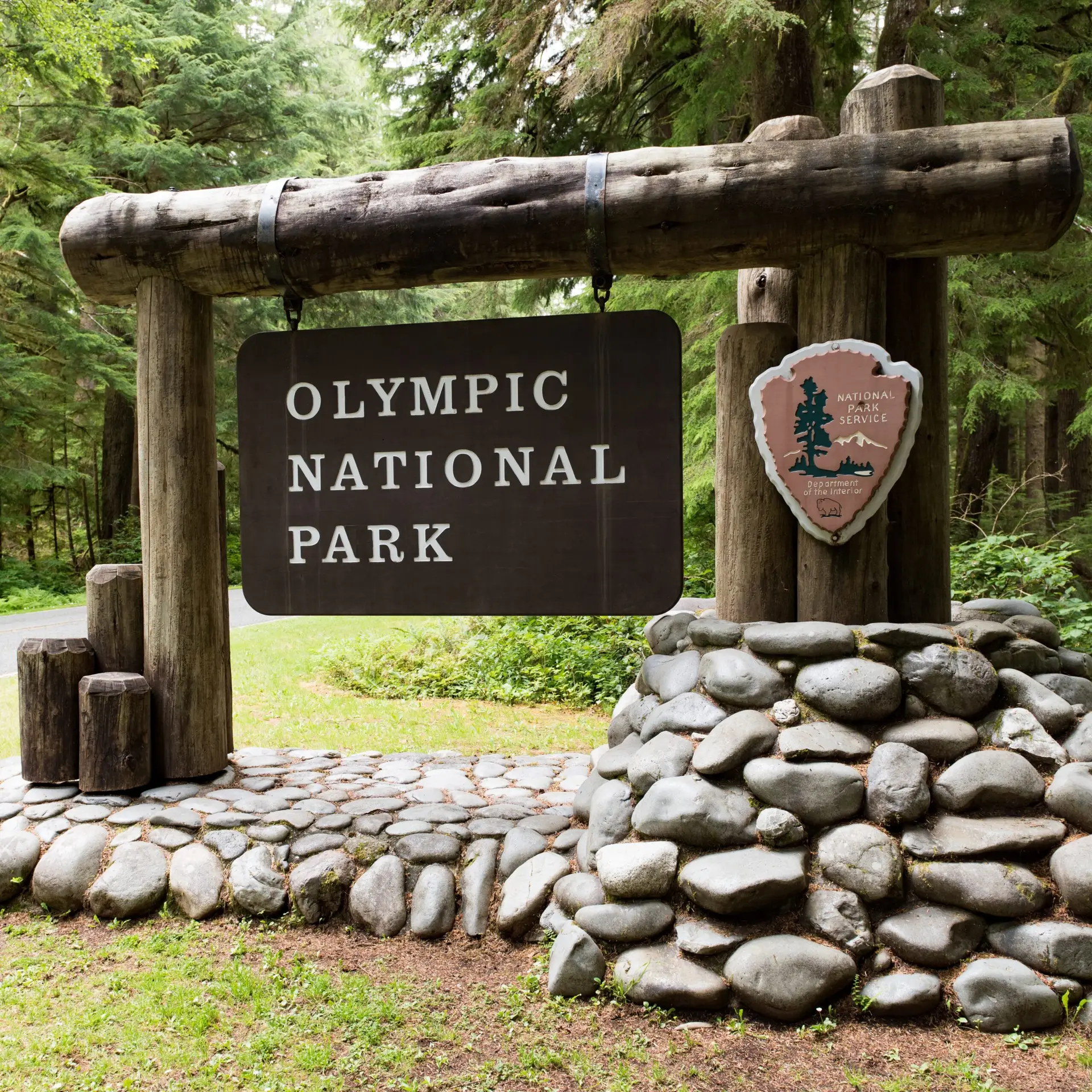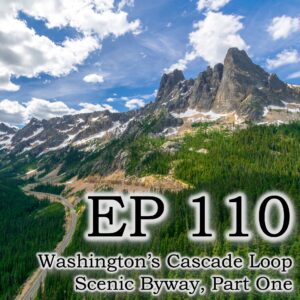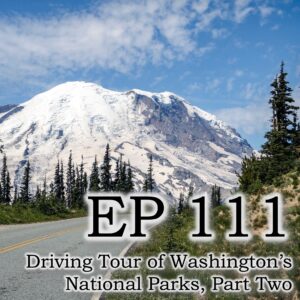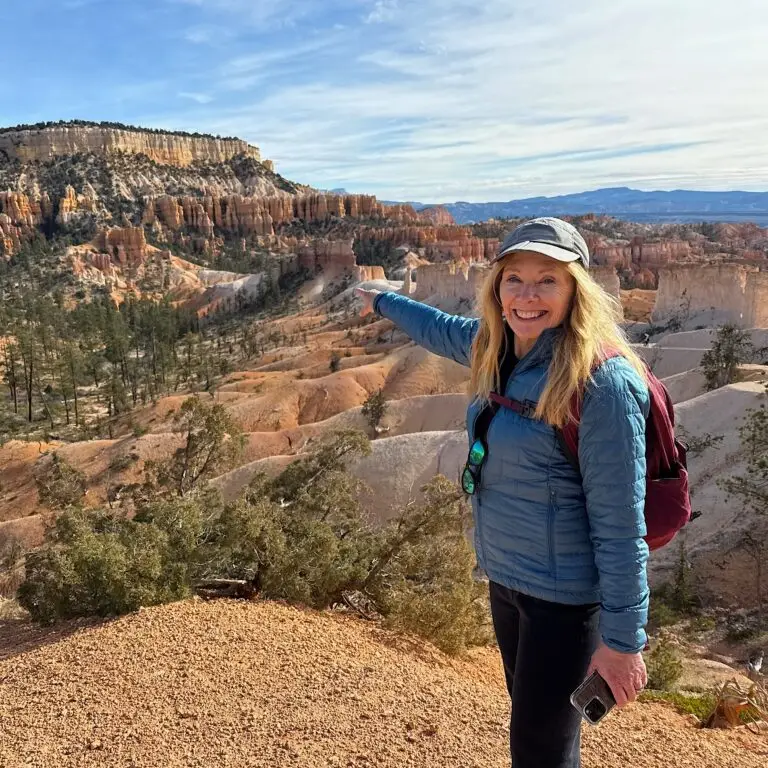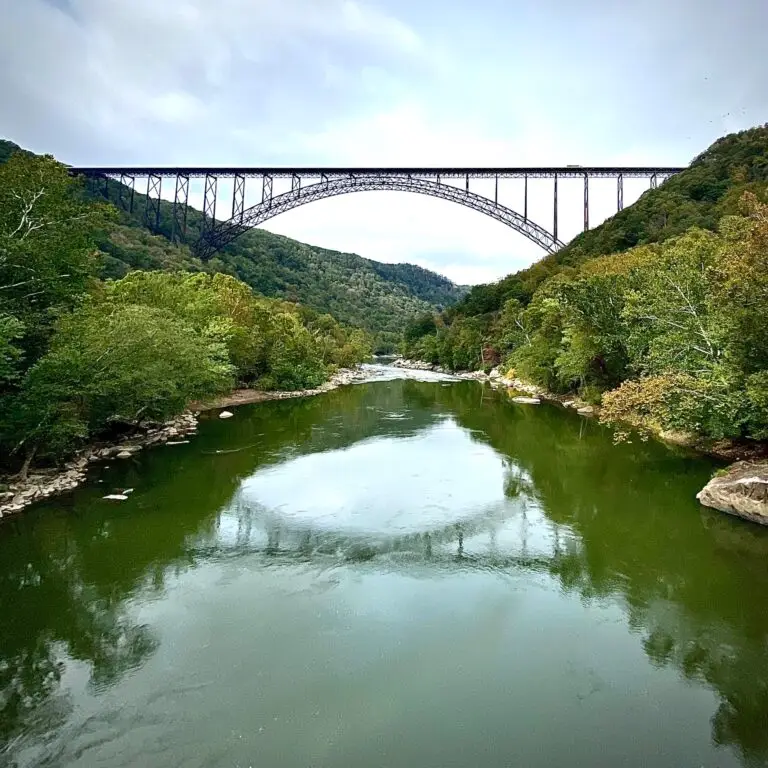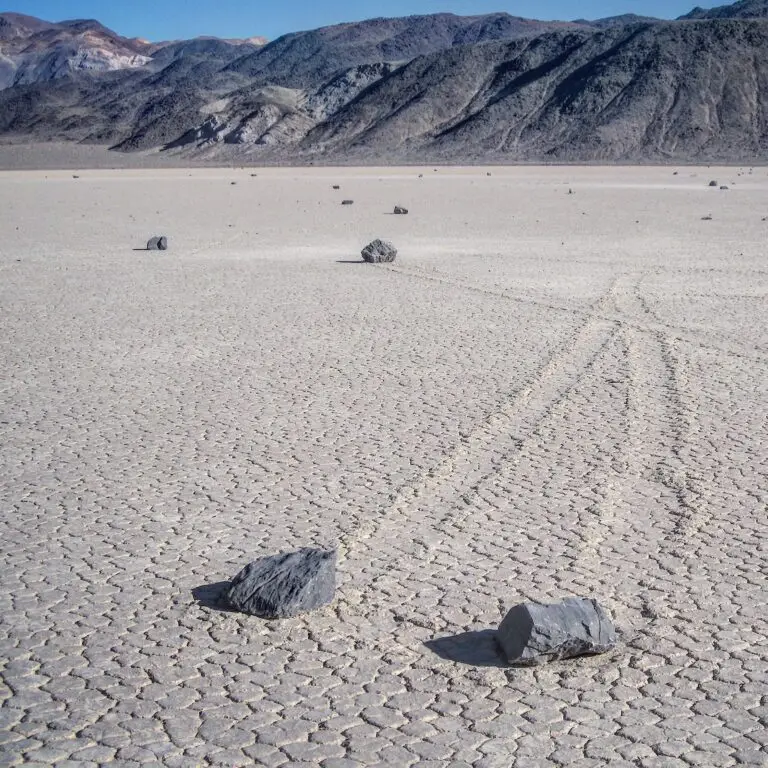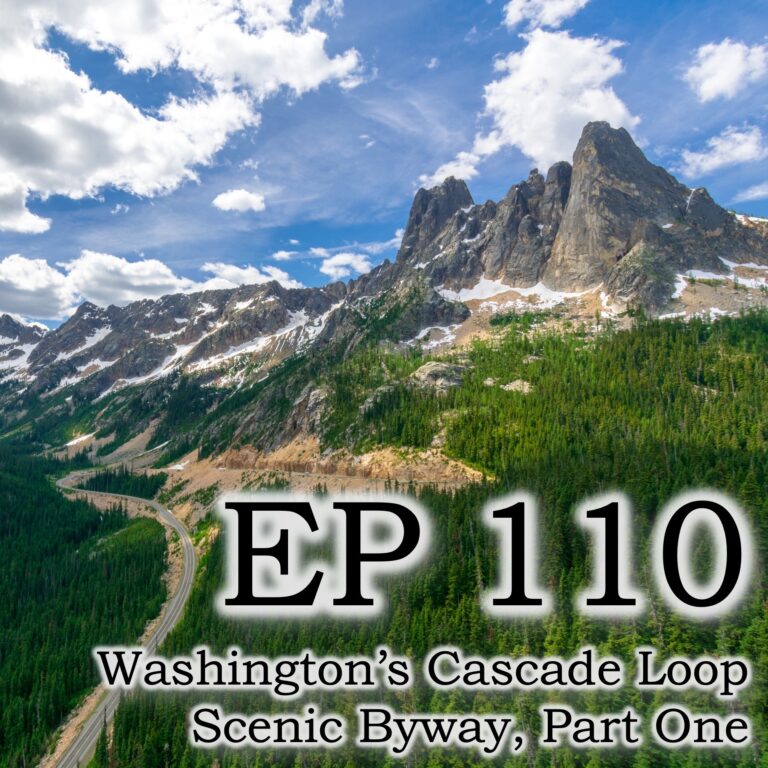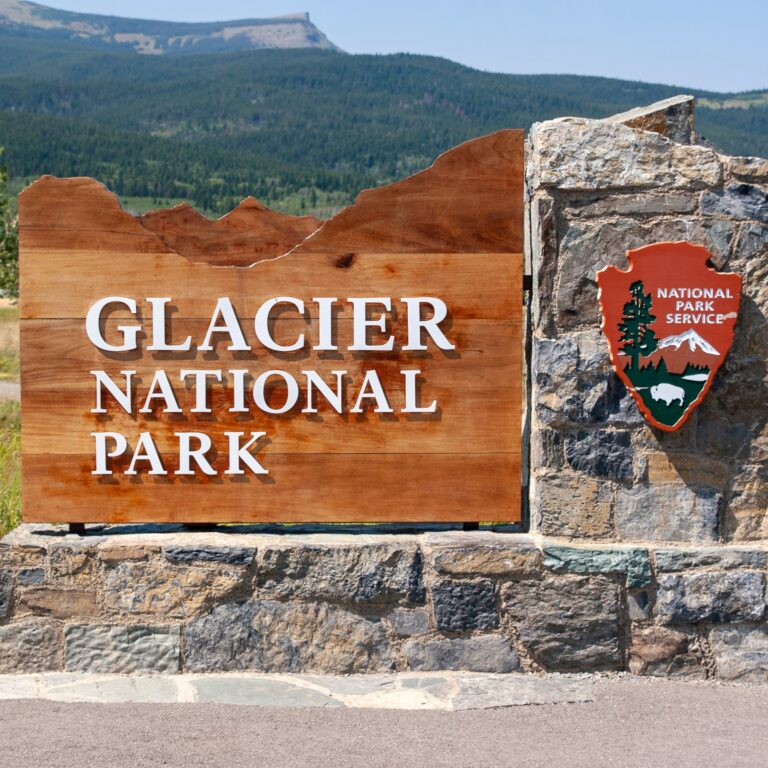Olympic National Park: Top Ten Things to See and Do
There’s a reason to visit Olympic National Park any time of year. While summer is best, each season offers visitors a chance to explore and enjoy this incredible natural resource. Regardless of how often we visit Olympic, we always leave wanting to go back as soon as we can find another couple of free days.
Here is our list of the top ten things to see and do in the park.
Table of Contents
- #1 Hurricane Ridge
- #2 Devil’s Punchbowl
- #3 Lake Crescent Lodge
- #4 Marymere Falls
- #5 Sol Duc Falls
- #6 Rialto Beach
- #7 The Hoh Rain Forest
- #8 Ruby Beach
- #9 Kalaloch Area Beaches
- #10 Quinault Rain Forest
Tune in to our hour-long podcast episode about Olympic National Park where we discuss these ten incredible places and more.
It’s a popular place
Olympic National Park might be more popular than most people realize. In 2023, it was the tenth most visited national park, with 2,947,503 visitors. Yet despite the number of visitors, it doesn’t feel as crowded as some of the other national parks.
Its size, and the fact that its popular attractions are spread across such a vast area helps control crowding. Also, people visit throughout the year, not just in one season.
Located on the Olympic Peninsula in the far northwestern area of Washington state, most out-of-state visitors fly in and out of Seattle. From SeaTac, you can drive around to the Peninsula or take a ferry across Puget Sound.
Highway 101 loops around the park’s eastern, northern, and western sides, and most, but not all, of the park is contained within this loop. The highway is free to drive; the park entrance fee stations are situated along the spur roads that go into the park, such as the roads to Hurricane Ridge, Sol Duc Falls, and the Hoh Rain Forest.
Begin in Port Angeles
The main park Visitor Center is located in Port Angeles, and this is where many people begin their visit to the park and its various regions. Our Top Ten list is not in order of preference, instead these places are listed in the order you’d reach them as you begin your journey in Port Angeles and work your way west, then south.
To view the full National Park Service park map, click here.
#1 Hurricane Ridge
To get a true sense of the park’s immensity, take time to visit Hurricane Ridge. The views from the top will give you a unique perspective of the peninsula’s size and diversity.
Starting just south of the Visitor Center, drive the 17-mile Hurricane Ridge Road to the top, where you’ll go from sea level up to 5,242 feet. This is the most easily accessible mountainous region of the park.
The road is open daily throughout summer. Get there early to avoid long lines at the entrance station and limited parking. At the top, you’ll find great hiking trails and incredible 360-degree views.
A great place for winter activity
Hurricane Ridge has some of the best snow for snowshoeing we’ve ever experienced. And on a blue bird day, the views are stunning. During the winter season, the average annual snowfall is 400-plus inches, so you can snowshoe, cross-country and downhill ski, snowboard, and go sledding and tubing. The road is scheduled to be open 9 am-4 pm Friday through Sunday and holiday Mondays, weather and road conditions permitting.
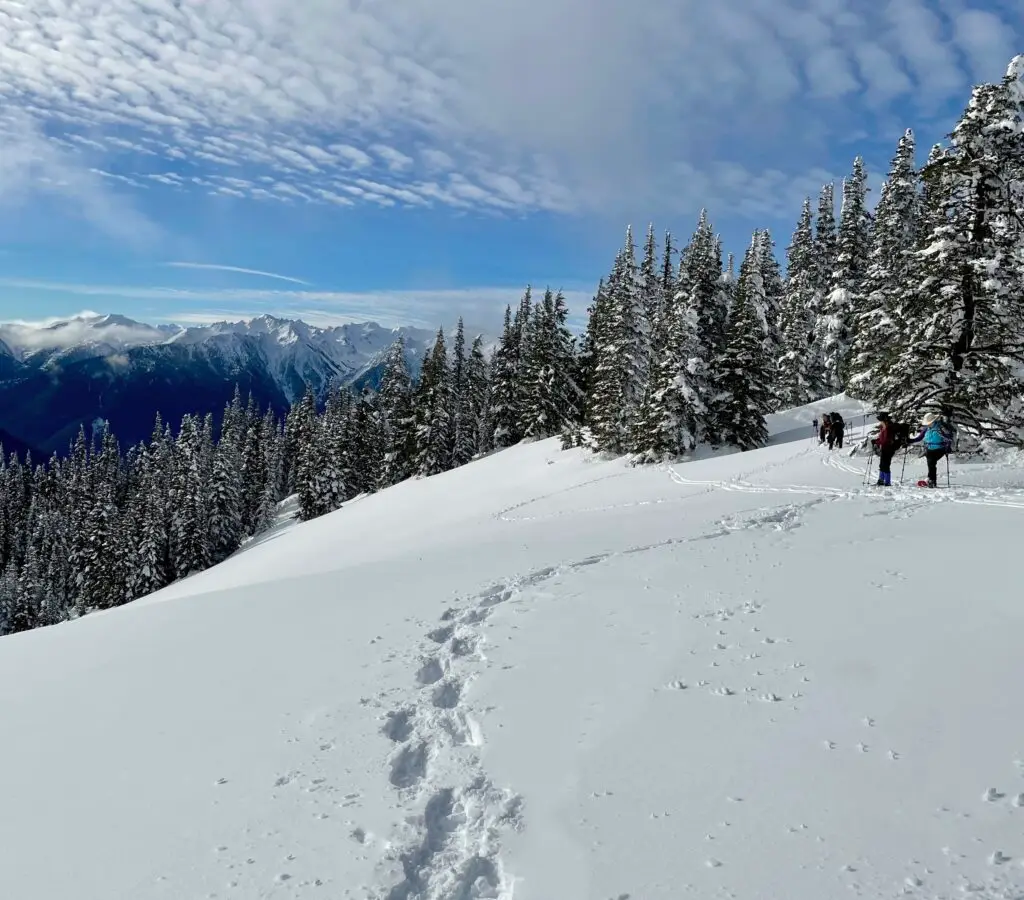
When the parking lot at the top is full, rangers at the entrance kiosk hold vehicles only allowing additional vehicles to enter when one exits the park. All cars, including 4-wheel-drive vehicles, are required to carry tire chains.
The Hurricane Ridge Day Lodge burned down on May 7, 2023, so unfortunately there’s no longer a gift shop, food service, or equipment rental available at the top. (However, restroom facilities are available.)
#2 Devil’s Punchbowl
Devil’s Punchbowl is becoming one of our favorite stops whenever we visit Lake Crescent and have extra time to head to the north side of the lake. You’ll find this charming area on its north shore, about one mile down the Spruce Railroad Trail. The trail is a repurposed railroad bed that is now paved. It’s part of the 130-mile Olympic Discovery Trail that runs from Port Townsend in the east to the seaside town of La Push on the Pacific Coast.
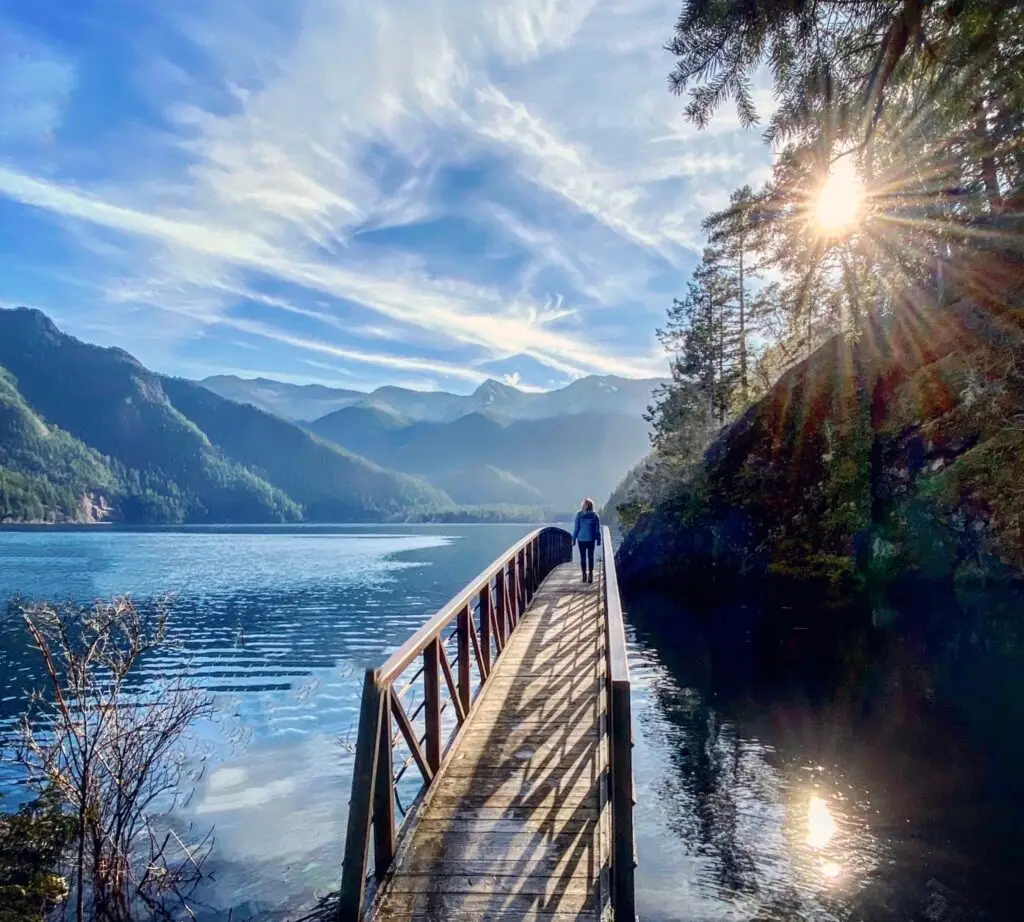
How to get there
While driving west from Port Angeles on Highway 101, turn right (north) onto East Beach Road just before you reach Lake Crescent. Follow this road for about 4 miles to a parking area by the Spruce Railroad Trail trailhead.
About a mile up the trail, you’ll come to a tunnel. Just before the tunnel, there is a side trail by the lake. It will be on your left as you’re looking into the tunnel. The Devil’s Punchbowl is a short distance down this trail. You can’t miss it because the bridge over the punchbowl is part of the trail.
This area is popular on warm, sunny days as a swimming hole and for taking pictures of the iconic bridge.
#3 Lake Crescent Lodge
The lodge sits in one of the most scenic settings for a park lodge you’ll ever see. It’s located on the south shore of Lake Crescent, about 25 miles west of Port Angeles on Highway 101.
Built in 1916, the lodge has cabins for rent and motel-style rooms in the main lodge building. They also have a dining room, lounge and coffee bar, gift shop, and boat rentals.
In 1937, President Franklin D. Roosevelt visited the Olympic Peninsula and stayed at Lake Crescent Lodge. Hence, the naming of the Roosevelt Cabins on the property. Roosevelt later signed into law the creation of the Olympic National Park in 1938.
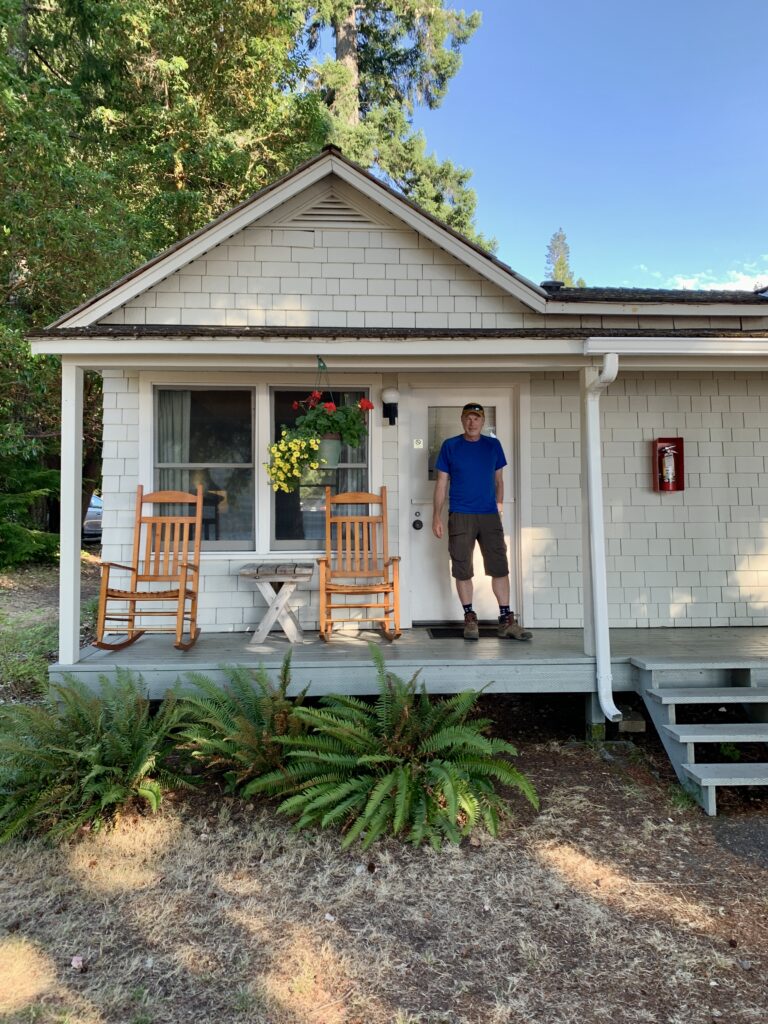
Lodging Availability
Winter Season January 5th – April 20th: The lodging website states that the Roosevelt Cabins and the Singer Tavern Cottages “remain open throughout the winter season for overnight stays on Friday, Saturday, and Sunday evenings. A two-night minimum is required during this time frame. The main lodge, including the front desk, restaurant, and gift shop, is closed during the winter.”
The lodge and facilities are open from April 25th through the end of December.
Stop by here and go into the lodge, maybe have a drink. On a sunny summer day, this is a great place to swim in the lake or rent a kayak or paddleboard. Keep in mind though, the beach can be crowded in the summer.
#4 Marymere Falls
This 90-foot spectacular waterfall is the payoff at the end of an easy trail through an old-growth forest: a 1.8-mile round trip with about 500 feet of elevation. On the trail are two scenic bridge crossings over Barnes Creek and Falls Creek.
Marymere Falls is a popular trail because it is a great trail for people of all fitness levels as well as families. Located close to Lake Crescent Lodge, you can park at the Storm King Ranger Station close by or at Lake Crescent Lodge.
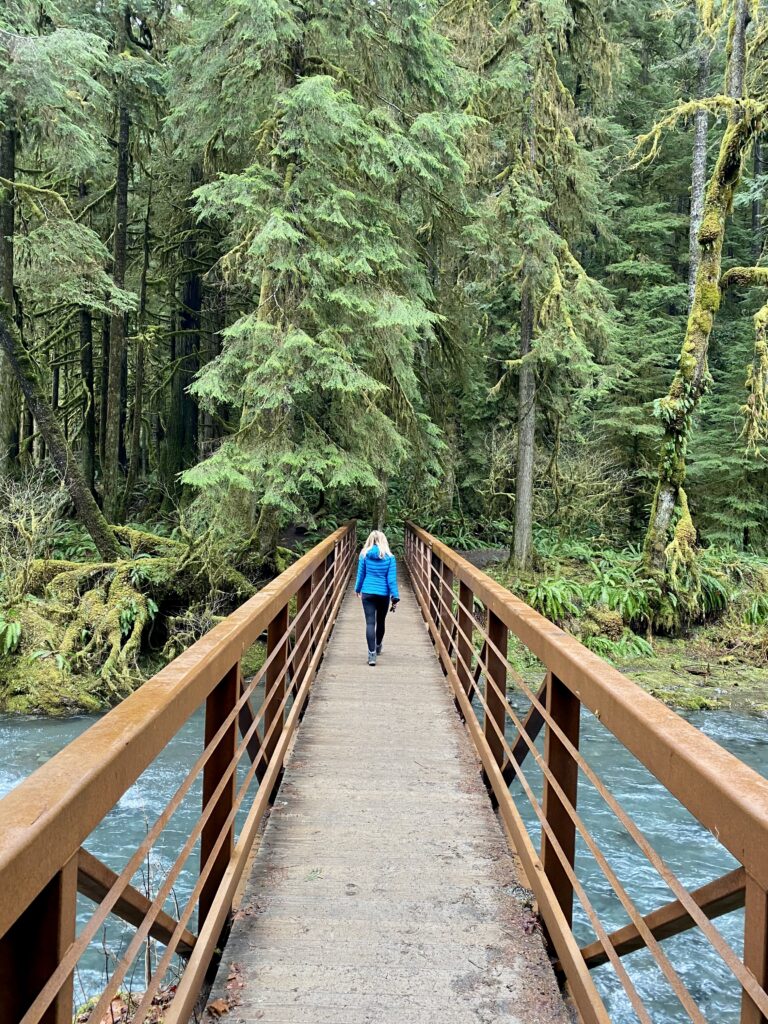
Are you up for a strenuous side trip?
On your way to the falls, you’ll pass the trail junction to Mount Storm King, a strenuous, 4-mile round trip hike with about 2,100 feet of elevation gain. This challenging but maintained trail ends at the climber’s trail, which is unmaintained and quite exposed.
The ropes leading to the top of the trail are not installed or maintained by the park, so know that if you rely on them, you are doing so at your own risk. All that said, there are incredible views of the lake and surrounding area at the top, but the summit has very little space for hikers to sit and rest.
#5 Sol Duc Falls
Sol Duc Falls is the most beautiful waterfall in the park, in our opinion, and one of the most unique falls we’ve ever seen.
While driving west on Highway 101 from Lake Crescent Lodge, the turnoff to Sol Duc will be on your left (south). Turn on Sol Duc Road. Soon you’ll reach an entrance kiosk. The trailhead will be about 14 miles from when you turn onto Sol Duc Road. This road can be closed in the winter due to ice and snowfall, so check online before you head there.
The hike to the falls is 1.6 miles round trip with about 200 feet of elevation gain. Like all waterfalls, the flow will be different depending on the season.
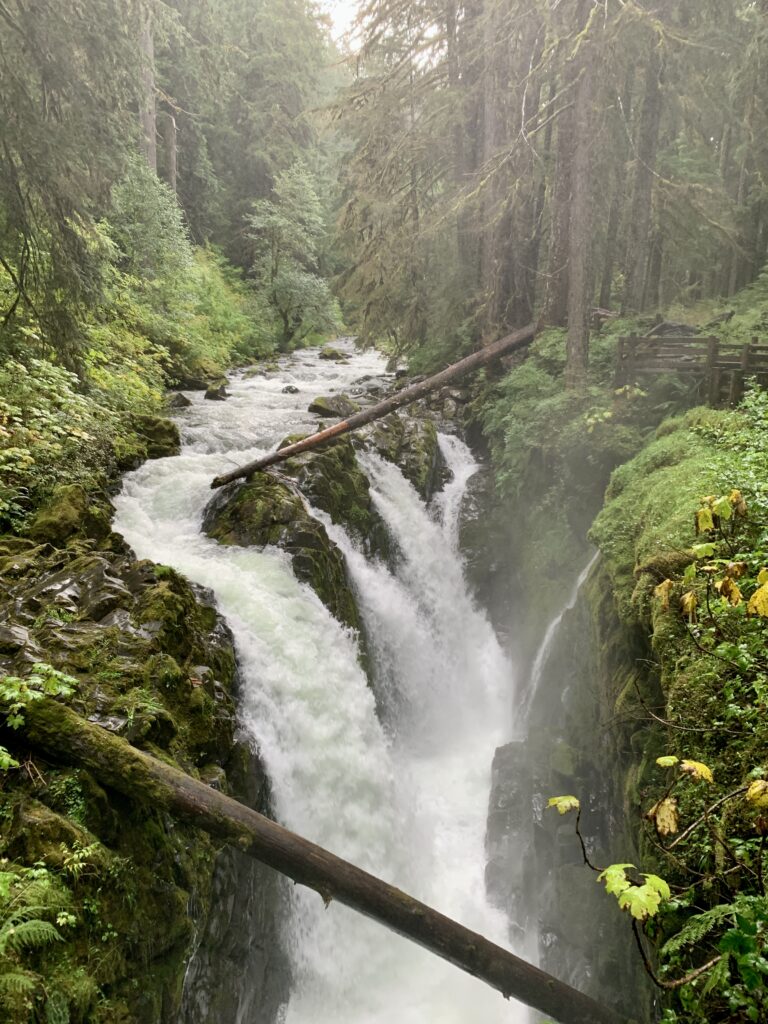
And there is a resort nearby
Sol Duc Hot Springs Resort is located directly on Sol Duc Hot Springs Road and features three natural hot mineral pools. Visitors don’t need to stay at the resort to use the pools, but they will have to pay an entrance fee. The Sol Duc Hot Springs Resort is only open between March and late October.
#6 Rialto Beach to Hole-in-the-Wall
Driving south on Highway 101, you’ll turn right (west) onto State Route 110. Drive about 13 miles to the Rialto Beach parking lot. The beach, just beyond a stack of old-growth-sized driftwood, is a perfect example of what to expect along the Pacific Northwest coast: rugged rock haystacks just offshore, invigorating surf, and amazing sea creatures in the tidepools.
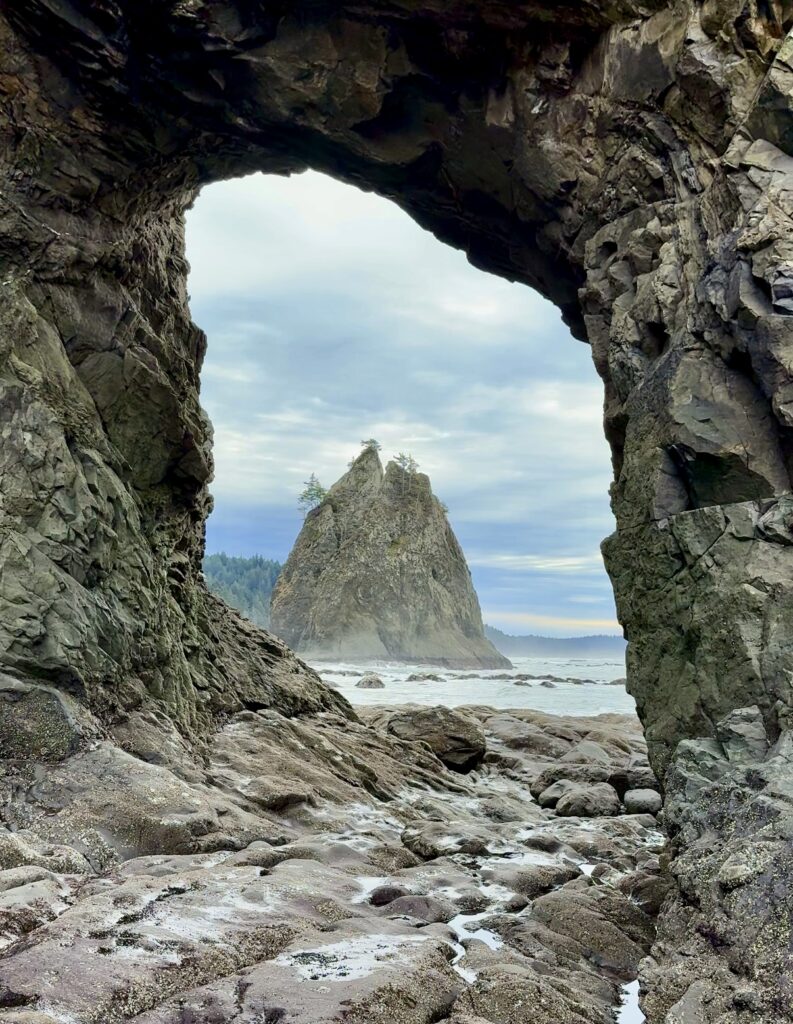
The Hole-in-the-Wall is a natural rock arch carved by the ocean into a point of land that juts into the sea about 1.5 miles north of the parking lot. You can reach it during low tide where you can explore the opening and the tide pools around it.
On your hike north from the parking lot, you will have to cross Ellen Creek, where the rushing water can be a few inches to a foot deep. So, we suggest wearing rubber boots if you don’t want to get your feet wet.
#7 The Hoh Rain Forest
The “Hoh” is as close to magical as it gets in the national parks. This is a must-see location and would probably make our top three list – if we had one – for the Olympics.
From Rialto Beach, drive back to Highway 101, turn right (south), and drive about 15 miles to reach Upper Hoh Road. Turn left (east) onto Upper Hoh Road. The Visitor Center parking lot will be another 18.5 miles.
The rain forest gets its name from the Hoh River, which carves its way from Mount Olympus to the east towards the Pacific Coast. The Hoh is an excellent examples of a temperate rain forest, and one of the best left in the United States. It is also one of the park’s most popular destinations.
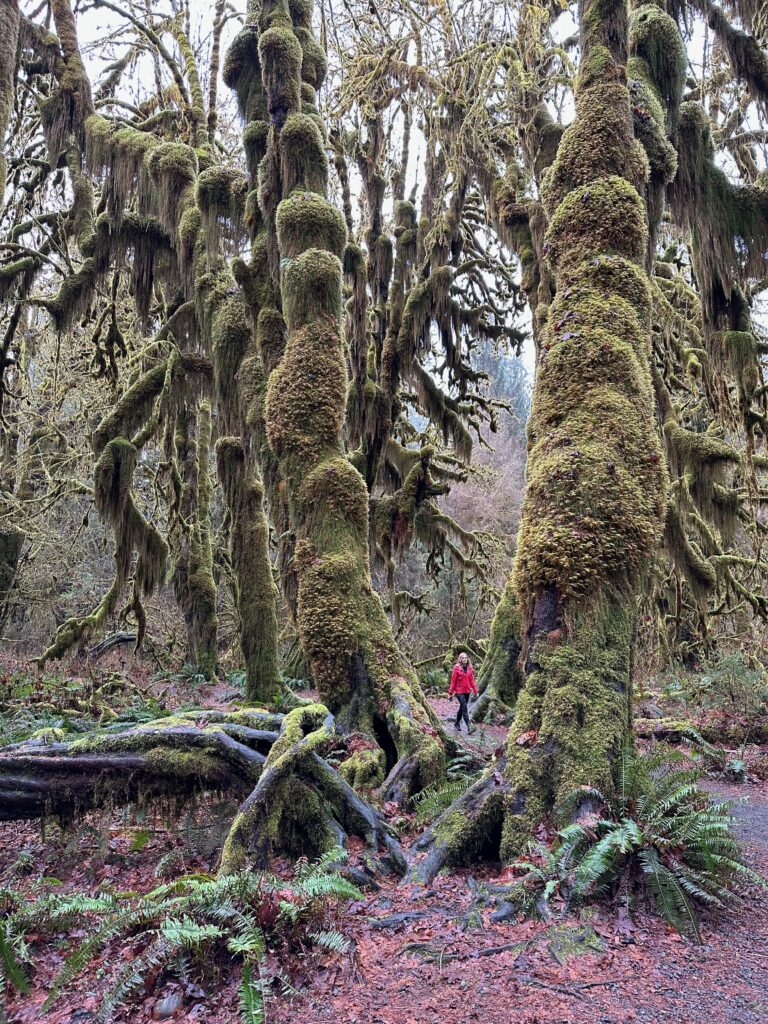
The Hoh gets a yearly average of 140 inches of precipitation. The result is an enchanted forest: a lush, green canopy of coniferous and deciduous species, mosses, and ferns.
Trails by the Visitor Center
- Hall of Mosses: .8-mile loop
- Spruce Nature Trail: 1.2-mile loop
- Hoh River Trail: runs for 18.5 miles to the Blue Glacier moraine below Mt Olympus
The road to Hoh can be backed for miles in the summer, so go early.
#8 Ruby Beach
Ruby Beach is named after the reddish sand that occasionally washes onto the beaches, and the large rock islands nearby known as sea stacks. This is a popular beach. Fortunately for visitors, it has a huge new parking lot.
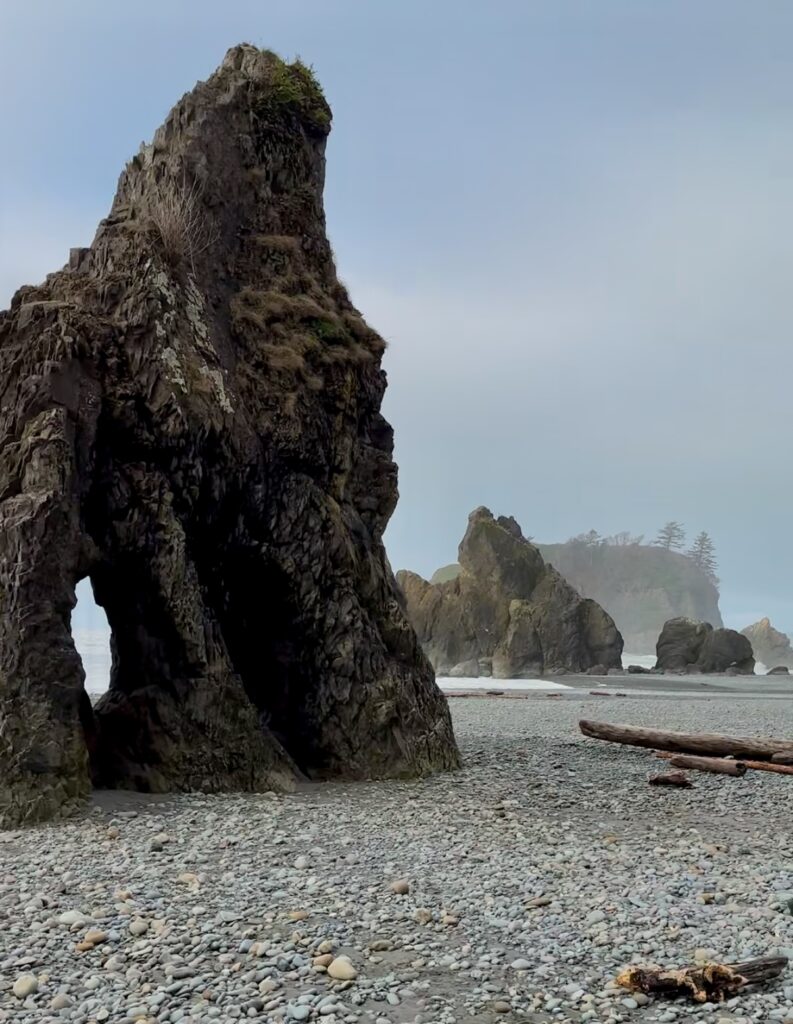
To the north, you can walk about three miles on the beach past several large sea stacks until you reach the Hoh River, where it flows into the sea.
It is sometimes possible to hike to the south during low tide about three miles to Steamboat Creek. There, you’ll have views of Destruction Island and its lighthouse to the west.
Ruby Beach is a great place for tide pooling at low tide. Be prepared to get your feet wet.
#9 Kalaloch: The lodge, beaches 1, 2, 3, 4, and the Tree of Life
Even if you stop by the beaches to the north, the ones in this area of the park are worth a visit. We could lose an entire day wandering these beaches; Karen always thinks she is one driftwood log away from finding a washed-up treasure that all the other beachcombers passed over.
Kalaloch Lodge and its cabins sit on the edge of a cliff overlooking the Pacific Ocean. This dramatic setting is a great place to stay overnight or have a meal in the restaurant. There is also a general store on the premises.
Located along the beach at Kalaloch Campground, the Tree of Life is seemingly suspended above a ravine along the bluff above the beach. The tree is popular with photographers but has sunk in recent years and is a less dramatic site than in the past.
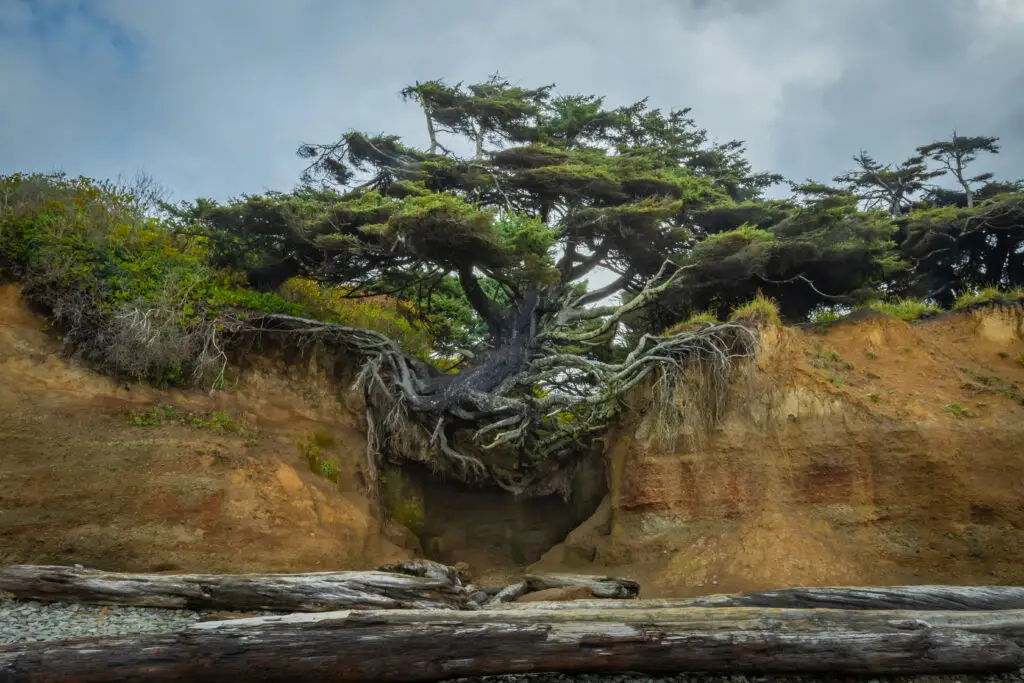
Source: Adobe Stock Images
Beaches 1, 2, 3, and 4 have unique personalities and are each worth exploring. They all require a short hike through the forest down to their beautiful beaches. Beaches 1, 2, and 3 only have pull-out parking along Highway 101. Beach 4 has a large, dedicated parking lot.
#10 Quinault Rain Forest
Quinault is not as popular as the Hoh Rain Forest, but it’s equally magical. It surrounds the stunning Lake Quinault, home to historic Lake Quinault Lodge, built in 1926.
Quinault is sometimes referred to as the “Valley of the Rain Forest Giants.” It is home to the world’s largest spruce tree and the largest western red cedar tree. This area offers both short nature trails and longer hikes.
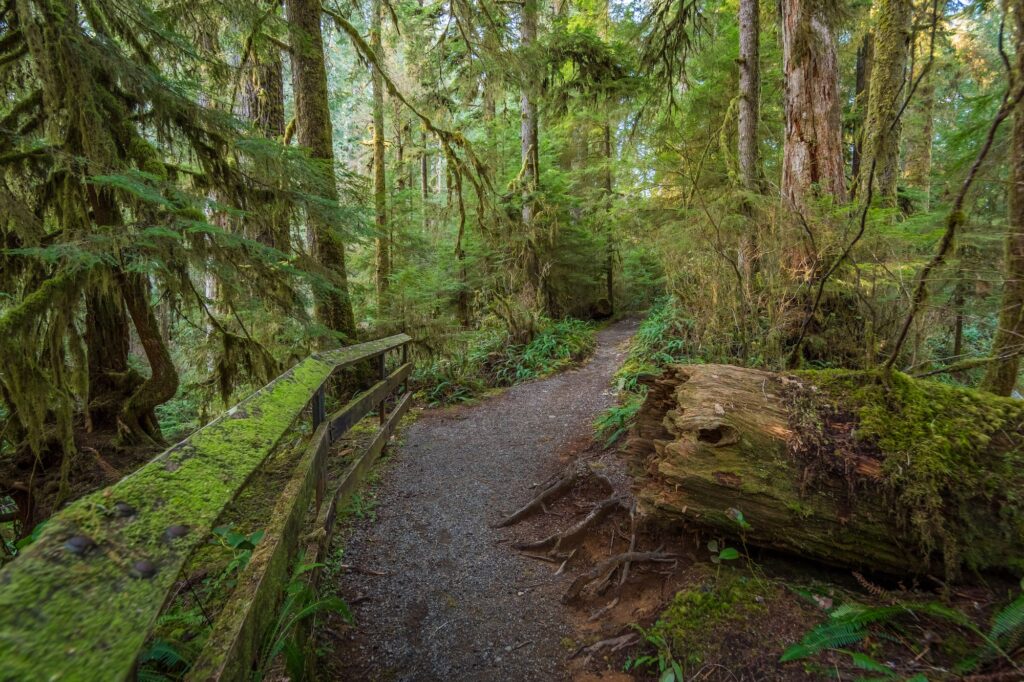
What about pets?
Olympic National Park is more dog-friendly than many other national parks. According to the park’s website, pets are allowed on the following trails:
- Peabody Creek Trail (Olympic National Park Visitor Center in Port Angeles)
- Rialto Beach parking lot to Ellen Creek (1/2 mile)
- The beaches between the Hoh and Quinault Reservations (Kalaloch area)
- Madison Falls Trail (Elwha)
- Spruce Railroad Trail (North shore of Lake Crescent)
- July Creek Loop Trail (North shore of Lake Quinault)
Pets are not permitted on any trails not listed above, in public buildings, on interpretive walks, or in the wilderness.
Where to stay
You’ll want to move your home base during your visit if you can. To visit the first five items on the list above, you could stay in Port Angeles or Lake Crescent Lodge. Then, if you can find lodging, move closer to the coastal areas and rain forests: Kalaloch Lodge, Lake Quinault Lodge, or even a motel in the Forks area.
There are also many campgrounds in the park and surrounding the park in Olympic National Forest
When to go
The park is worth visiting any time of the year, but summer and fall are best for the best: the weather is ideal, yet the crowds are larger. We like to go in January and February because we have the park to ourselves, but you’ll need warm clothing, a raincoat, and waterproof footwear. Just note, if you go in the winter, Sol Duc Falls won’t be available, Hurricane Ridge will only be open Friday through Sunday, and Lake Crescent Lodge facilities will be closed.
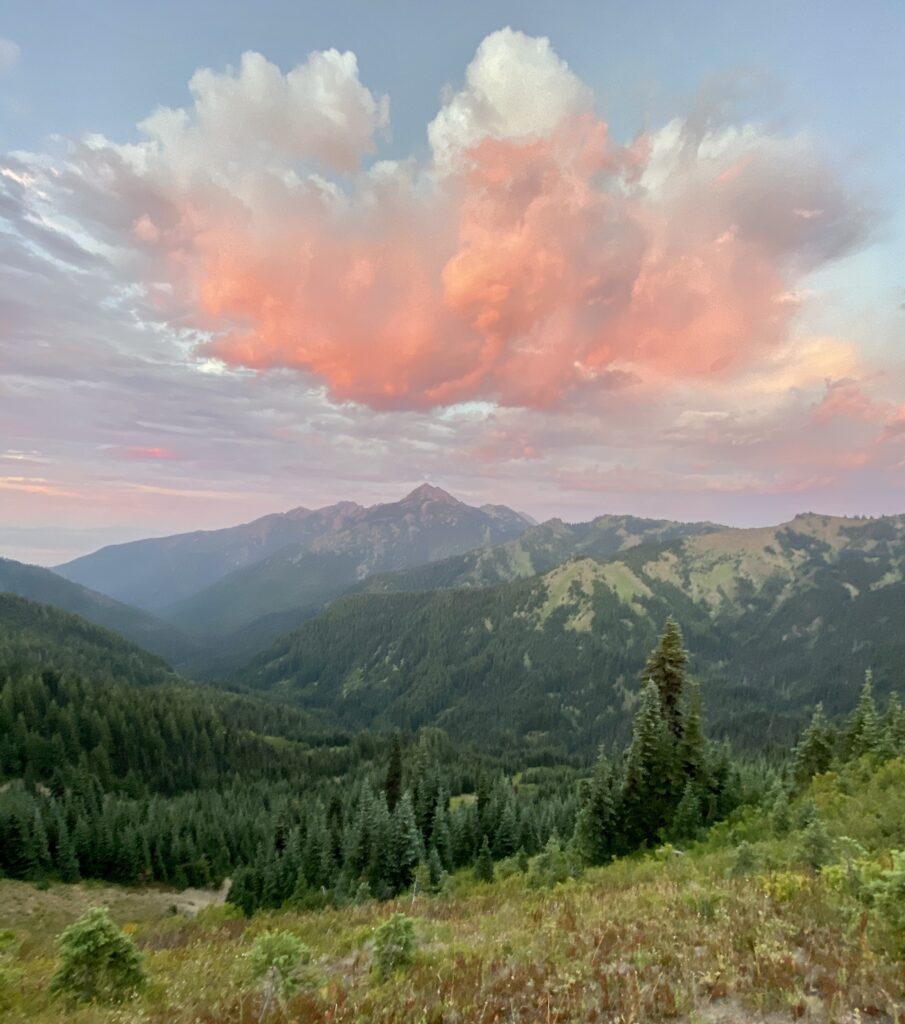
How many days will you need?
Three days would be the perfect amount of time to see all the places on our top ten list. If you want a more relaxed pace, four days would be plenty.
Check out our other podcast episodes
If you have more time to explore the area, you could head to Mount Rainier and North Cascades National Parks. Check out our podcast two-part series (episodes #110 and #111) on how to visit all three of these parks in one trip.
